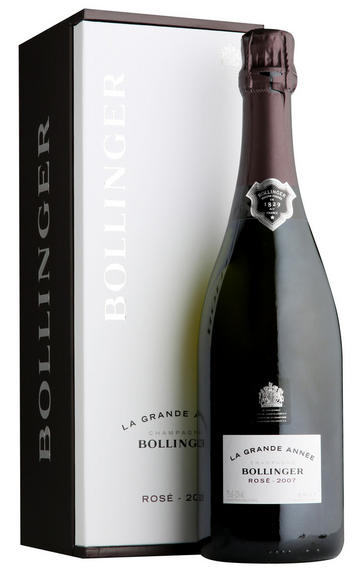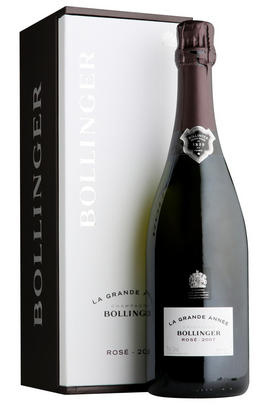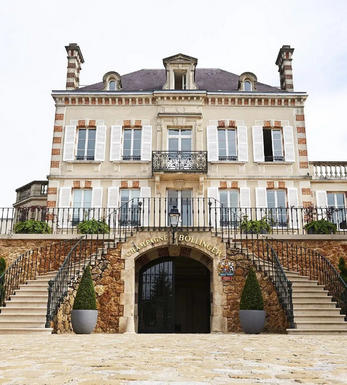
2007 Champagne Bollinger, La Grande Année, Rosé, Brut

Critics reviews
William Kelley - 30/04/2019
About this WINE

Bollinger
The Champagne House of Bollinger was established in 1829 by Jacques Bollinger and Paul Renaudin. Over the years the vineyard holdings have been steadily increased with the largest expansion taking place under the stewardship of the legendary Mme Lily Bollinger. She ran the company between 1941 and 1977 and today it is managed by her great-nephew, Ghislain de Montgolfier.
Bollinger has a reputation for producing muscular champagnes with body, depth and power, and is today considered one of the "Great" Champagne houses.
70% of the grapes come from the firm's own vineyards. 80% of the harvest is barrel-fermented with the wines being kept on their yeast lees for an extended period of time (in the case of the RD, around 10 years).
Bollinger produces classic, complex, Pinot-Noir dominated champagnes with the ability to age gracefully for many years.

Rosé Champagne
Rosé wines are produced by leaving the juice of red grapes to macerate on their skins for a brief time to extract pigments (natural colourings). However, Rosé Champagne is notable in that it is produced by the addition of a small percentage of red wine – usually Pinot Noir from the village of Bouzy – during blending.
Recommended Producers : Billecart Salmon (Elizabeth Salmon Rose), Ruinart

Champagne blend
Which grapes are included in the blend, and their proportion, is one of the key factors determining the style of most Champagnes. Three grapes are used - Pinot Noir, Chardonnay and Pinot Meunier.
26% of vineyards in Champagne are planted with Chardonnay and it performs best on the Côtes des Blancs and on the chalk slopes south of Epernay. It is relatively simple to grow, although it buds early and thus is susceptible to spring frosts. It produces lighter, fresher wines than those from Burgundy and gives finesse, fruit and elegance to the final blend. It is the sole grape in Blancs de Blancs, which are some of the richest long-lived Champagnes produced.
Pinot Noir accounts for nearly 40% of the plantings in Champagne and lies at the heart of most blends - it gives Champagne its body, structure, strength and grip. It is planted across Champagne and particularly so in the southern Aube district.
The final component is Pinot Meunier and this constitutes nearly 35% of the plantings. Its durability and resistance to spring frosts make the Marne Valley, a notorious frost pocket, its natural home. It ripens well in poor years and produces a soft, fruity style of wine that is ideal for blending with the more assertive flavours of Pinot Noir. Producers allege that Pinot Meunier lacks ageing potential, but this does not deter Krug from including around 15% of it in their final blends.


Buying options
Add to wishlist
Description
Bollinger’s straight 2007 is a surprisingly good bottle of wine and the newly released 2007 rosé has again far exceeded expectations. The nose is a delicious interplay of rose petals, strawberries and raspberries along with slightly more mature notes of juicy currant and soft brioche. A broad swathe of textured red berry fruit presents itself confidently upfront with notions of crème pâtissière, almond and bruised apple slotted in behind. This is a complex and immediately appealing rosé enlivened by well integrated acidity that reveals itself on the back end. Great on its own but this also has the credentials to be an excellent match with food. Drink now to 2025.
Peter Newton, Private Account Manager
Given the house's connection to Bond, 007 sounds like a brilliant Bollinger vintage. Normally, I'm not so fond of the vintage's correct, but somewhat neutral character. I remember that major investments were made by the house at this time and the results are excellent. In my world, this is one of the most surprising vintages from the small boutique house in Aÿ. From the start, this rosé reminds us of the great vintages in the 80's, when the house style was more nutty and smoky than later years, somewhat easier and peachy creations. Tasted next to a Vieilles Vignes Francaises of extraterrestrial eminence from the same year, the wine stood well with a huge poise and power in a rich burgundy style. The aromas are dominated by dried roses, blood orange, forest mushroom, leather and hazelnut cream.
94/100 (95/100 potential). Richard Juhlin
wine at a glance
Delivery and quality guarantee